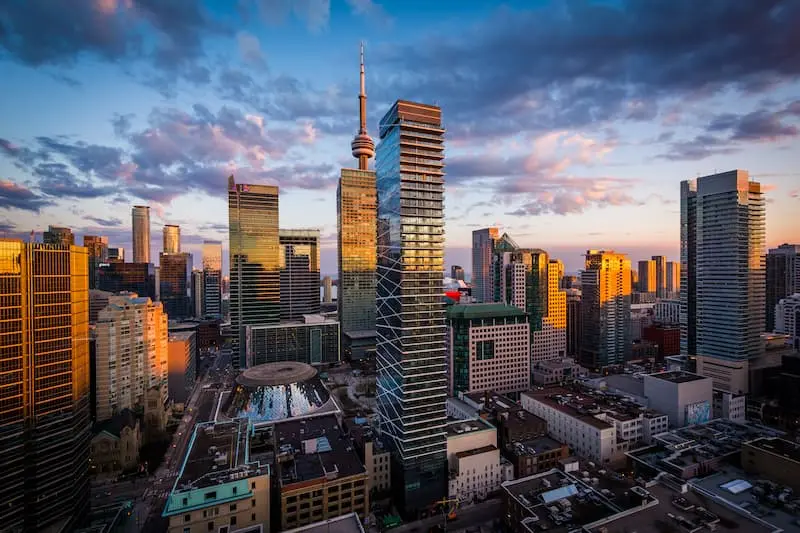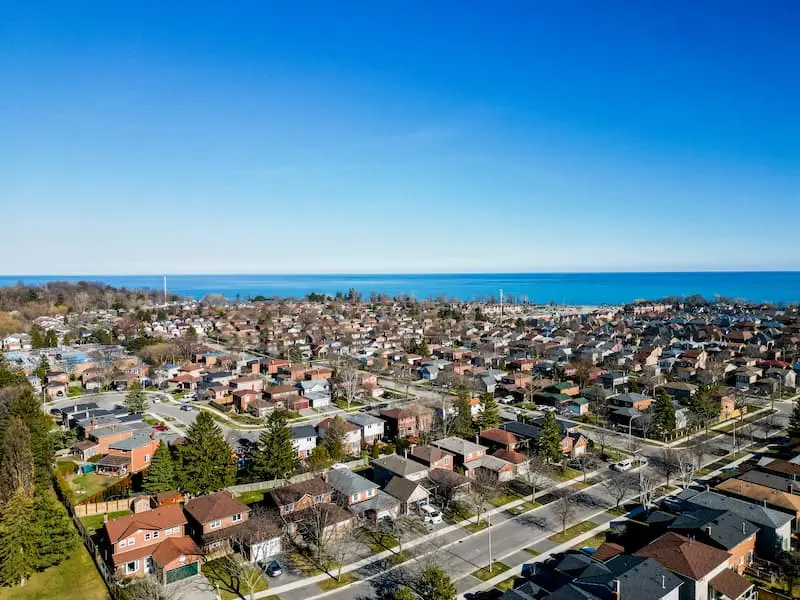As Canada’s largest city, Toronto offers a wide variety of options for work, entertainment, food, education, and outdoor activities. Its diversity draws new homebuyers from all over the world, giving the city and its surrounding areas a unique flavour unlike anywhere else in North America.
The Greater Toronto Area (GTA) is home to a variety of communities. There are expansive cities that are bigger than many places elsewhere in Canada. But there are also smaller towns with historical appeal and loads of charm. It’s in these communities where homebuyers will find options to put down roots while remaining relatively close to Toronto’s bustling downtown.
Population: 717,961 (Canadian census 2021)
Median home value: $1.39 million
Median household income before taxes: $102,000
Mississauga, located just west of Toronto, is one of Canada’s largest and fastest-growing cities, with data projecting that the area will grow to 812,000 by 2031. The city is characterized by its modern housing infrastructure, such as the Absolute Towers, which were named as the Best Tall Buildings in the Americas in 2012.
Major employers in Mississauga include Maple Leaf Foods, Hatch, Bell Mobility, PepsiCo, and Canon Canada.
Mississauga consistently ranks among the safest cities in Canada, making it an ideal place for families to settle down and raise children. The city is characterized by its well-maintained neighborhoods, excellent schools, recreational amenities, and community services, providing residents with a high quality of life.
For outdoor activities, check out green spaces such as Erindale Park, one of the largest parks in the city, with great views of the Credit River. There’s also the Credit Valley Conservation Area, where visitors can hike or spend the day birdwatching.
Population: 124,579 (Canadian census 2021)
Median home value: $1.543 million
Median household income before taxes: $126,000
Milton is located southwest of Mississauga and is part of the Halton region of the GTA. It boasts a thriving economy supported by some of the region’s biggest employers such as Siemens Canada, Johnson & Johnson, and Whirlpool Canada. These employers provide a stable job market and opportunities for career growth, making Milton an attractive destination for professionals and job seekers.
Milton offers residents access to plenty of parks and outdoor spaces. Kelso Conservation Area is a popular destination, offering hiking trails, picnic areas, and views of the Niagara Escarpment.
One of the unique aspects of Milton is its perfect blend of small-town charm and urban amenities. Despite its rapid growth, Milton has managed to maintain a strong sense of community and connection among its residents, making it an appealing place to put down roots.
Population: 126,665 (Canadian census 2021)
Median home value: $850,000
Median household income before taxes: $119,000
Ajax is a 43-kilometre drive from Toronto and is in the eastern portion of the GTA. With plenty of outdoor and urban appeal, as well as public transportation options such as the GO Train to take residents to the heart of downtown Toronto, Ajax has lots to offer potential homebuyers.
Ajax contains a diverse economy with numerous employers across various sectors. Major employers include companies such as Volkswagen Canada. The vehicle maker operates a manufacturing plant in the city that produces engines for VW and Audi. Other employers such as Veridian Corporation, and the Ajax-Pickering hospital operated in the area.
For those looking to spend time outdoors, the city has many options. Ajax has over 70 parks, including the expansive Greenwood Conservation Area, where residents can hike, bike, or simply enjoy nature. Rotary Park offers waterfront views and is ideal for picnics and family outings. Additionally, the Ajax Waterfront Park features trails, playgrounds, and scenic spots for walking or cycling along Lake Ontario.
Population: 99,185 (Canadian census 2021)
Median home value: $1.038 million
Median household income before taxes: $118,000
Located right next to Ajax on the western side, Pickering is part of the Durham region. The city is a large draw for families looking to purchase single-family homes while remaining close to Toronto.
Pickering is known for its the nuclear generating station, and it is a significant employer in the region. Additionally, the Pickering Innovation Corridor is attracting companies in sectors such as technology, healthcare, and advanced manufacturing, further diversifying the local job market.
The city is well-connected via highways, including Highway 401, and public transit options such as GO Transit and Durham Region Transit, making it convenient for commuters to travel to Toronto and surrounding areas for work or leisure.
Residents of Pickering enjoy access to numerous parks and green spaces. The Waterfront Trail offers scenic views of Lake Ontario and stretches across several parks, including the popular Petticoat Creek Conservation Area, where families can picnic, hike, or enjoy the beach. Millennium Square and Esplanade Park are waterfront destinations with walking paths, playgrounds, and event spaces.
Population: 175,380 (Canadian census 2021)
Median home value: 773,000
Median household income before taxes: $86,000
Oshawa is located east of Ajax and is approximately 60 kilometres east of downtown Toronto.
Oshawa has a rich industrial heritage, particularly in the automotive industry. The city was once home to the McLaughlin Motor Car Company, which later became General Motors of Canada.
Oshawa is still a hub for manufacturing and technology, with several major employers contributing to the local economy. General Motors of Canada operates assembly plants in Oshawa, employing thousands of workers in automotive manufacturing and innovation. Additionally, the University of Ontario Institute of Technology (UOIT) and Lakeridge Health are significant employers in the education and healthcare sectors, respectively.
Oshawa offers lots of parks and outdoor spaces where residents can enjoy nature and recreational activities. Lakeview Park is a popular destination with waterfront views, sandy beaches, and picnic areas. For nature enthusiasts, the Second Marsh Conservation Area offers birdwatching, hiking trails, and educational programs, showcasing Oshawa’s local biodiversity.
Population: 56,742 (Canadian census 2021)
Median home value: $795,000
Median household income before taxes: $103,000
Bowmanville is found 15 kilometres east of Oshawa, and approximately 75 kilometres from Toronto. With its smaller size and proximity to Toronto, Bowmanville’s popularity is quickly growing.
Bowmanville retains its small-town atmosphere while still providing residents with essential amenities and services. The historic downtown area features unique shops, cafes, and restaurants and residents enjoy a sense of belonging with their neighbors in this close-knit community.
Bowmanville is home to several major employers that contribute to the local economy and provide job opportunities for residents. One of the largest employers in the area is the Darlington nuclear generating station, operated by Ontario Power Generation. The station employs a significant number of workers in the energy sector, providing economic stability to the community.
Bowmanville is surrounded by plenty of countryside and green spaces. The nearby Bowmanville Valley Conservation Area offers hiking trails, picnic areas, and scenic viewpoints, allowing residents to enjoy outdoor activities year-round.
Population: 20,519 (Canadian census 2021)
Median home value: $600,000
Median household income before taxes: $77,000
Cobourg is the largest town in Northumberland County and is located 95 kilometres east of Toronto. As the smallest community on this list, Cobourg is known for its well-preserved heritage buildings, such as Victoria Hall, which dates to the 1850’s and serves as Cobourg’s current town hall. The downtown area boasts Victorian architecture, boutique shops, and cafes. There’s also an attractive waterfront. Cobourg harbour sits on Lake Ontario and is also home to its marina.
Cobourg is home to several major employers that contribute to the local economy and provide job opportunities for residents. One of the largest employers in the area is Cameco Corporation, a leading uranium producer. Cameco’s facility in Cobourg employs hundreds of workers in uranium fuel manufacturing and processing.
For residents interested in long distance cycling, Cobourg is a great starting point since it’s the beginning of the Rice Lake Ramble and the Shelter Valley signed cycling loops. The Ontario Great Lakes Waterfront Trail also passes through the town and cyclists can bike the flat terrain along the water’s edge.
Population: 147,829 (Canadian census 2021)
Median home value: $789,900
Median household income before taxes: $93,000
About 90 kilometres north of Toronto, Barrie sits on the shore of Lake Simcoe. With a growing tourism economy thanks to summer and winter resorts, Barrie offers its residents plenty to do during every day of the year.
Skiers and snowboarders can explore two different hills: Mount St. Louis Moonstone and Snow Valley Ski Resort. Meanwhile, the year-round Horseshoe Resort has a lift-operated bike park for downhill biking adventures in the summer, as well as skiing and snowshoeing in the winter.
Barrie is home to several major employers across various industries, providing residents with a plethora of career opportunities. Some of the largest employers in Barrie include Napoleon Home Comfort, Georgian College, Royal Victoria Regional Health Centre, Honda of Canada Manufacturing, and Hydro One.
Population: 656,480 (Canadian census 2021)
Median home value: $900,000
Median household income before taxes: $111,000
Located north of Mississauga, Brampton is another one of the GTA’s larger cities and is known for its cultural diversity.
Brampton boasts a robust economy supported by a range of industries, including manufacturing, retail, healthcare, and logistics. Some of Brampton’s largest employers include Loblaw, Fiat Chrysler, Rogers Communications, Amazon, and Medtronic Canada.
Brampton has plenty of options for outdoor fun. Chinguacousy Park is known for its expansive green space, playgrounds, tennis courts, and ski hill. Meanwhile in downtown Brampton, residents will find the historic Gage park. This space includes gardens, a fountain, and an outdoor ice skating rink in the winter.
Population: 323,105 (Canadian census 2021)
Median home value: $1,200,000
Median household income before taxes: $107,000
Drive 35 minutes north of Toronto and homebuyers will find Vaughan, a city made famous by possessing the largest permanent amusement park in the country, Canada’s Wonderland.
Vaughan boasts a strong and diverse economy, with a focus on industries such as manufacturing, retail, healthcare, and technology. Some of Vaughan’s largest employers include Cortel Group, the Vaughan Mills Shopping Centre, Martinrea International, UPS Canada, and Northbridge Financial Corporation.
In addition to the amusement park, there are plenty of activities to explore in Vaughan. At the Kortright Centre for Conservation, residents can explore trails throughout the 325-acre nature preserve. Meanwhile, children can participate in educational programs that range from primary to secondary school offerings.











